Want to get the best painting robot on the market but don’t know your options?
Perhaps you’re confused because many industrial robots can be used for painting?
Here are 5 of the top painting robots specifically designed for professional-grade surface finishing.
Painting robots were in the news last year when a robot artist, name Ai-Da, became the first to stage an exhibition. This follows on from the controversial $432,500 sale of a robot-produced artwork titled “Edmond de Belamy” in 2018.
But, most of us are not looking for artistic merit when we are looking for a painting robot. We just want a reliable robot that is easy to program and gives us the surface finish that we need for our product.
Many industrial robots can be used for painting. However, the task is sometimes difficult to achieve due to the slightly complex interaction between the different components and the safety requirements of the robot.
A few robot manufacturers have tackled this problem head-on with their integrated painting solutions. Below, we list some of the top robots for painting.
What Features Does a Painting Robot Need?
There are a few features that are necessary for good quality robot painting. These enable the robot to quickly and flexibly paint any object with the minimum of waste.
- Enough Degrees of Freedom — The more DoF that a robot has, the more able it is to approach a particular point from multiple angles. This is important as the painting tool must retain an exact distance from the surface to ensure a consistent paint job wherever it is in the robot’s workspace.
- Atomizer — The business end of any paint tool. This turns the liquid paint into a spray or fine mist for application on the work surface.
- Paint Pump— This pumps the paint from its storage receptacle into the paint tool.
- Color Changer— Some painting robots allow you to switch between different paint colors quickly by using a color changer. The switching process can produce some wastage as the old color needs to be flushed out of the atomizer.
- Hollow wrists — A defining feature of dedicated painting robots is that they have a hollow wrist. This means that the cables and paint tubes can run through the wrist, rather than outside it, and avoids them getting covered in paint.
- Explosion-proof— Working with flammable liquids like paint presents a real danger of explosions. Dedicated painting robots are often built to be “explosion-proof” to ensure that, if an explosion does happen, the robot will be able to withstand it.
- Paint Programming Software— Any robot application needs a good system for programming. Ideally, you want a software which makes it easy to program complex painting trajectories with the minimum of programming. RoboDK includes a tool that can produce a painting path automatically from any curve on the 3D model of your workpiece.
Various systems for robot painting will require other extras and accessories. But, these are the core features you will probably need.
7 Top Painting Robots for Professional Surface Finishing
Thankfully, you don’t need to buy all of the extras individually! Some robot manufacturers have created ready-built painting solutions which include all of the extras you will need for your painting application.
- KUKA and Dürr’s ready2_spray
German company Dürr has long been a market leader in the automotive industry, providing assembly and painting solutions. A couple of years ago they teamed up with robot manufacturer KUKA to produce the ready2_spray solution.
The solution is based around KUKA’s AGILUS KR 10 R1100 robot and provides all of the necessary components for a painting robot. They even created a cutesy animation on the ready2_spray webpage which demonstrates the difference between this and a normal KUKA painting robot.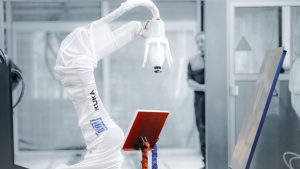
- FANUC’s PaintMate
Another big name in the robotics world, FANUC’s dedicated painting solution is the PaintMate series. Like the previously mentioned solutions, it is explosion-proof via compliance to the ATEX directive for equipment working in an explosive environment.
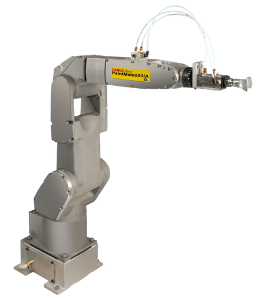
PaintMate comes in a variety of different sizes, each based around one of FANUC’s robot models.
- B+M Surface Systems
Although a lesser-known robot manufacturer than the previous options, German company B+M Surface Systems specializes in surface finishing technologies, ranging from dipping technologies to robotic painting solutions.
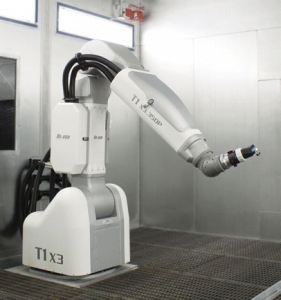
- ABB’s FlexPainter
ABB was the pioneer of painting robots way back in the late 1960s. Their newest painting robot, the FlexPainter, continues to innovate with their new ABB Ability Connected Atomizer — the “world’s first digital automotive robotic painting system.”
Like other painting robots, the Flexpainter (based around the IRB 5500) has a large work envelope, allowing it to reach across even large workpieces to paint the other side.
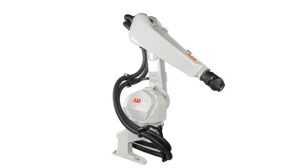
- Kawasaki’s Robotic Painting
Kawasaki provides its own robotic painting solution based on its K-Series robots. Like all the robots on this list, they come with a range of peripherals which improve the painting experience and, importantly, are suited to the pressurized environment of a painting booth.
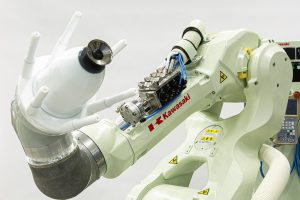
- Yaskawa’s MPX/MPO Series
Yaskawa provides its Motoman MPX/MPO Series robots which are designed for painting tasks.
Like the other robots listed here, these Motoman’s can be mounted in a variety of configurations (e.g. from the ceiling, wall or floor) allowing for greater flexibility in the painting task.
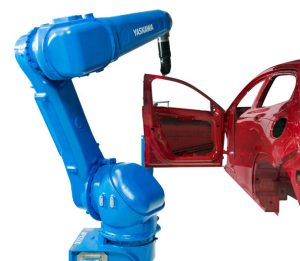
- Stäubli Paint Robots
Stäubli’s paint solutions are based around some of its TX and RX robots. Process parameters are controlled via the company’s PaintiXen software, which controls the parameters like flow rate, atomization, and electrostatic charge. Stäubli claims that this software reduces solvent and paint by 30%.

How to Program a Painting Robot
With all of the robots listed, the default programming options are through the teach pendant or the manufacturer’s programming language. Both can be an arduous way to program a robot.
However, with offline programming, you can program paint trajectories in minutes. Many of the robots on this list are compatible with offline programming by using the appropriate post-processors.
Many of the models listed can be found in our Robot Library, meaning that they can be controlled by RoboDK within minutes. This allows you to quickly and easily program painting paths using only your 3D model as an input.
